POPE LEO XIV
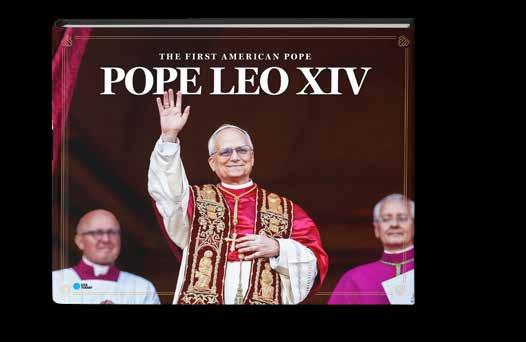
On the cover
Cardinal Robert Prevost, newly elected as Pope Leo XIV, is seen on the Saint Peter’s Basilica balcony, at Saint Peter’s Square in the Vatican, on May 8, 2025. JAKUB PORZYCKI / NURPHOTO
RIGHT: Pope Leo XIV waves to people as he arrives on the popemobile for his inaugural Mass at the Vatican, May 18, 2025. MATTEO MINNELLA / REUTERS
Copyright © 2025 by USA TODAY • All Rights Reserved
ISBN: 978-1-63846-172-2
No part of this book may be reproduced, stored in a retrieval system or transmitted in any form or by any means, electronic, mechanical, photocopying, recording or otherwise without prior written permission of the copyright owner or the publisher.
Published by Pediment Publishing, a division of The Pediment Group, Inc. • www.pediment.com • Printed in Canada.
This book is an account of Pope Leo’s life by USA TODAY and is not endorsed by the Vatican or Pope Leo.
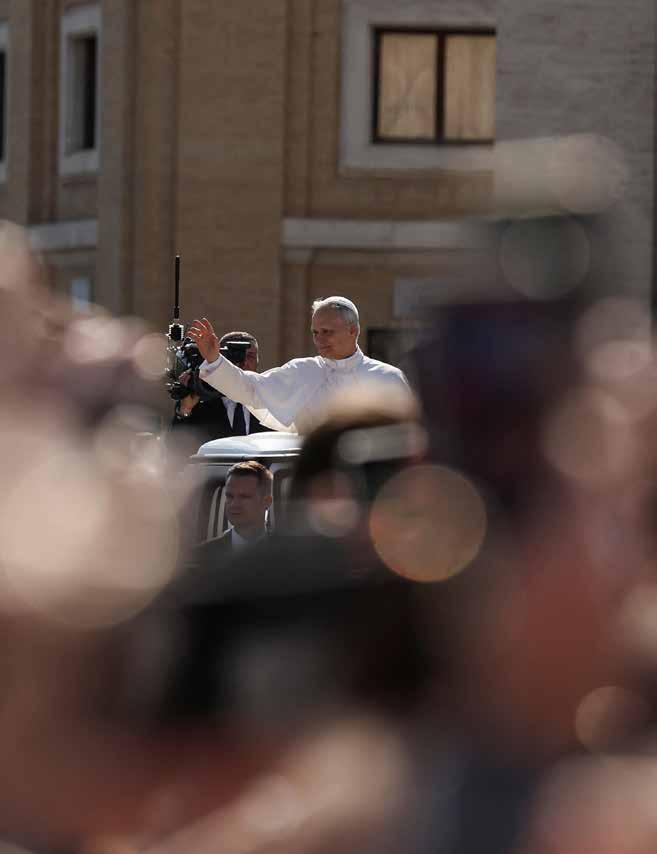
The Excerpt podcast from USA TODAY: May 10, 2025, transcript
Taylor Wilson, USA TODAY: Good morning. I’m Taylor Wilson, and today is Saturday, May 10th, 2025. This is The Excerpt. Today, Pope Leo XIV and his first days at a new job. Plus Republicans are at odds on some aspects of a bill dealing with President Trump’s priorities, and the National Science Foundation cancels more grants.
Pope Leo XIV marked his first full day as leader of 1.4 billion Roman Catholics by celebrating Mass in the Vatican’s Sistine Chapel.
[Music]
Taylor Wilson: Mass got underway as the first American Pope processed into the chapel and sang in Latin, along with the Vatican’s Sistine Chapel choir, one of the oldest and most prestigious in the world. The first two readings were delivered in English and Spanish.
Pope Leo XIV: “As we celebrate this morning, I invite you to recognize the marvels that the Lord has done, the blessings that the Lord continues to pour out upon all of us.”
Taylor Wilson: Leo also invoked Pope Francis, saying in Italian that his predecessor often taught that Catholics, “Are called to bear witness to our joyful faith in Christ the Savior,” according to the Vatican News. Leo also said that missionary outreach is desperately needed. You can read more from Pope Leo XIV’s first days in his new position with a link in today’s show notes. …

Staff
Editor
William Ramsey
Designers
Joey Schaffer, Lee Benson
Proofreader
Heather Hewitt
Project coordinator
Gene Myers
Special thanks
Chris Fenison; Kristen Ramsey, a sharp eye and mind
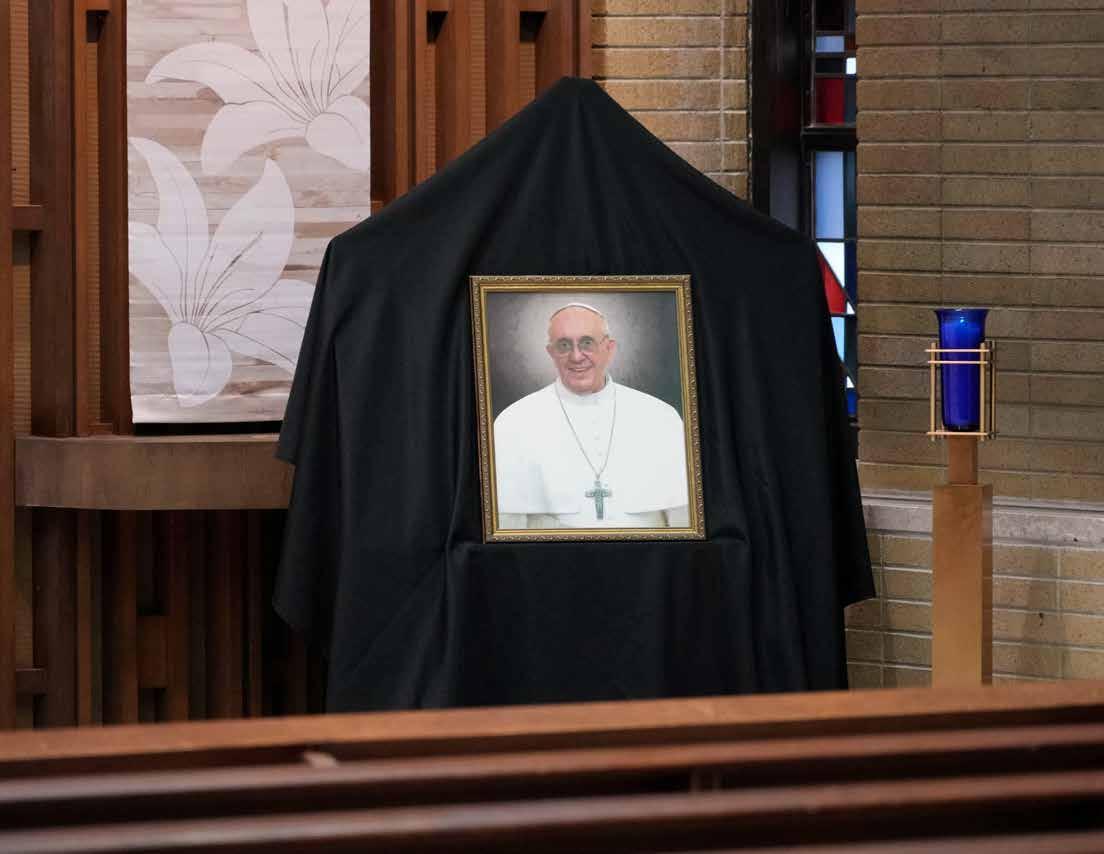
Foreword
Fascination with papacy’s rituals takes center stage
MARC RAMIREZ, USA TODAY
Acloaked and timeless figure with a regal authority spanning centuries, the pope is a global icon whose appearances draw hundreds of thousands and whose influence as leader of the Catholic Church extends well beyond his flock of 1.4 billion adherents.
Even in the United States, where Americans have gradually abandoned organized religion, the magnitude of the pope’s sway commands the attention of Catholics and non-Catholics alike. Interest might ebb and flow depending on the person who fills the role, but the kingly complexion of the papacy itself continues to hold enduring intrigue.
“Particularly for Americans who are not Catholic, there’s something analogous with the interest in European royalty, a kind of timeless institution that doesn’t exist here,” said R. Andrew Chesnut,
chair of Catholic studies at Virginia Commonwealth University in Richmond. Pope Francis, who died April 21, was unique in that he was able to ease the papacy’s rarefied air with an unassuming approachability, said Mathew Schmalz, a professor of religious studies at The College of the Holy Cross in Worcester, Massachusetts. “Pope Francis combined being a part of an ancient institution but also made it down-to-earth and more accessible,” said Schmalz, a founding editor of the Journal of Global Catholicism.
Popes have captured the spotlight by increasingly wielding their influence in world affairs. Pope John Paul II’s 1979 pilgrimage to Poland played a vital role in the collapse of Eastern European communism, and Francis emphasized social and cultural issues affecting the world’s marginalized and poorest people.
“The head of the Catholic Church is the head of an institution that claims over 1 billion baptized members and is arguably the most multicultural and multilingual institution in the world,” said John McGreevy, a professor of history at the University of Notre Dame in South Bend, Indiana. “There’s nothing quite like it.”
With the death of the 266th pontiff, the church will soon undertake perhaps its most storied practice — the process of electing a new leader. The traditions surrounding selection of a new pope date to the 13th century, which gives the proceedings a ritualistic air recalling that of the British monarchy.
“As I tell my non-Catholic friends, Catholicism makes great TV,” said Francis DeBernardo, executive director of New Ways Ministry, a national Catholic outreach group advocating for LGBTQ+
acceptance and equity. “Especially since ‘Game of Thrones,’ there’s a fascination with medieval ways and customs. So much of the papacy and the election of the new pope is steeped in those medieval times.”
The papacy essentially is a kingship, DeBernardo said.
“Despite our 1776 revolutionary ethos, we are fascinated with monarchy,” he said. “Look at how many Generation X people watch royal weddings. It’s the same thing.”
FRANCIS, THE ‘ROCK STAR’
Francis eschewed the regal trappings of the papacy, instead beloved for his humility and accessibility, including his decision to live in Santa Marta, a Vatican guesthouse, rather than the Apostolic Palace.
OPPOSITE: An image of Pope Francis is displayed at the Archdiocese of Milwaukee in St. Francis before Milwaukee Archbishop Jeffrey S. Grob discusses the death of the Pope on April 21, 2025. MIKE DE SISTI / MILWAUKEE JOURNAL SENTINEL
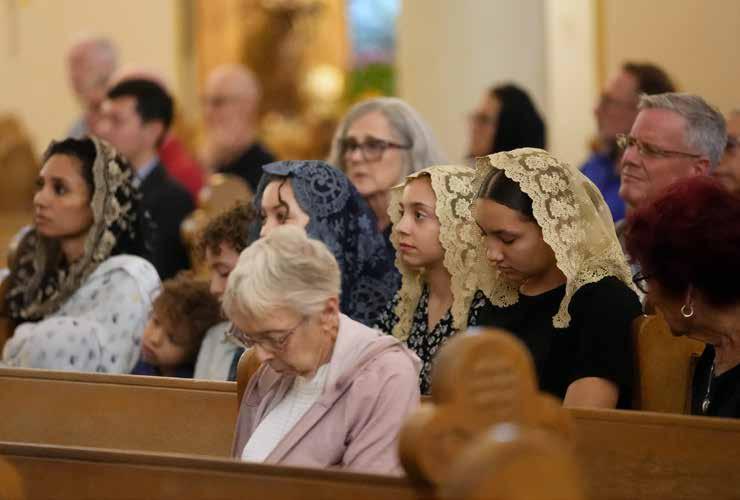
Francis did more than any of his predecessors “to diminish the monarchical dimensions of the papacy,” McGreevy said. “His informal personal style, the willingness to carry his own luggage and live in Santa Marta, all reflected a caution about the idea of the pope as a prince of sorts.”
His celebrity surpassed the role’s inherent fascinations, garnering both affection and scorn for his progressive views on social and cultural concerns such as climate change, immigration and LGBTQ+ issues.
a professor of history at Arizona State University who has written about religion, culture and politics in early America. As the conclave tackles the task of selecting his successor, she said, “my guess is there will be great American interest in a way that did not happen in the last election.”
Jonathan Tan, a professor of Catholic studies at Case Western Reserve University in Cleveland, agreed.
“There is clearly a palpable sense of loss of a visionary leader who made important paradigm shifts, coupled with mixed feelings of apprehension and hope about the likelihood — or lack thereof — of the next pope continuing Pope Francis’ legacy,” Tan said.
The clash places the church at a crossroads, promising even more scrutiny over who the church’s 267th pope will be.
THE MYSTERIOUS CONCLAVE
“Francis was a rock star,” Chesnut said. “His status transcended his Catholic base. So much of his agenda resonated in secular society with many folks who aren’t Catholics because they’re very pressing social-economic issues.”
Those views also made Francis a polarizing figure.
“Pope Francis was reviled in certain quarters in great measure because of his interesting approach to LGBTQ issues and other things,” said Catherine O’Donnell,
The new pope will be elected through perhaps the church’s most storied practice, the papal conclave, a centuries-old tradition laden with ritual, secrecy, intrigue and global ramifications. The enigmatic exercise, with its ceremonial votes scrawled on slips of paper behind the locked doors of a 15th-century sanctuary, culminates with the sight of white smoke from the Sistine Chapel chimney.
Frederic Baumgartner was an eighth grader in private school when Pope Pius XII died in 1958. Soon afterward, he remembers, the nun teaching his class switched on the radio to catch the announcement that Pope John XXIII had been named his successor.
“It grabs the attention of not just Catholics but people across the world,” says Baumgartner, professor emeritus of
history at Virginia Tech in Blacksburg and author of “Behind Locked Doors: A History of the Papal Elections.”
The release of the 2024 Netflix thriller “Conclave,” which portrays the machinations of a fictional papal conclave, has only amplified that interest by highlighting those signature elements, Tan said.
“Those include the complete separation and sequestration of the cardinal electors during the whole process, the total sworn secrecy of the voting, the behind-the-scenes negotiations to secure the necessary two-thirds majority, as well as the traditional pomp and ritual,” Tan said. “These same factors have certainly added an aura of mystique to a secretive and tradition-filled process.”
Because the process is shrouded in secrecy, there is no open campaigning or endorsing of candidates.
“These guys are locked into the Vatican and can’t leave until they make a decision,” Baumgartner said.
Fascination with the whole affair, he said, goes back centuries.
“Many Protestants were interested in papal elections in the 1600s and 1700s, in part because it was the only elective office in European society,” he said.
Massimo Faggioli, a professor of theology and religious studies at Pennsylvania’s Villanova University, said one intriguing aspect of the conclave is its elective process in a vastly hierarchical organization.
“It’s a paradox,” he said. “It’s a monarchy without a dynasty: It has to be by election to avoid the creation of dynasties or legacies.”
The secrecy of the conclave is designed to shield the vote from external pressures, Faggioli said.

“In the old days, they had to keep out the influence of the powerful families of Rome,” he said. “Emperors and kings wanted to have a voice. In the last few decades, the most important pressure has been the media. In the 20th century it was mass media; now it’s social media.”
Additionally, Faggioli said, the composition of the College of Cardinals, the church’s most senior members, has
changed dramatically, expanding far beyond Italy and Europe to become much more global. Francis himself, born Jorge Mario Bergoglio of Argentina, was the first pontiff to originate from the Americas.
“It has become more exotic,” Faggioli said. “There are now many cardinals from Asia and North Africa who are potential popes. That makes it different than it has been for many centuries.”
ABOVE: A picture of Pope Francis is left on the steps at St. Mary’s Basilica in Phoenix on April 21, 2025. Francis died Easter Monday following a lengthy bout of double pneumonia, the Vatican said. MICHAEL CHOW / THE REPUBLIC
CHAPTER ONE
CHOOSING A NEW POPE
“Peace is built in the heart and from the heart, by eliminating pride and vindictiveness and carefully choosing our words.”
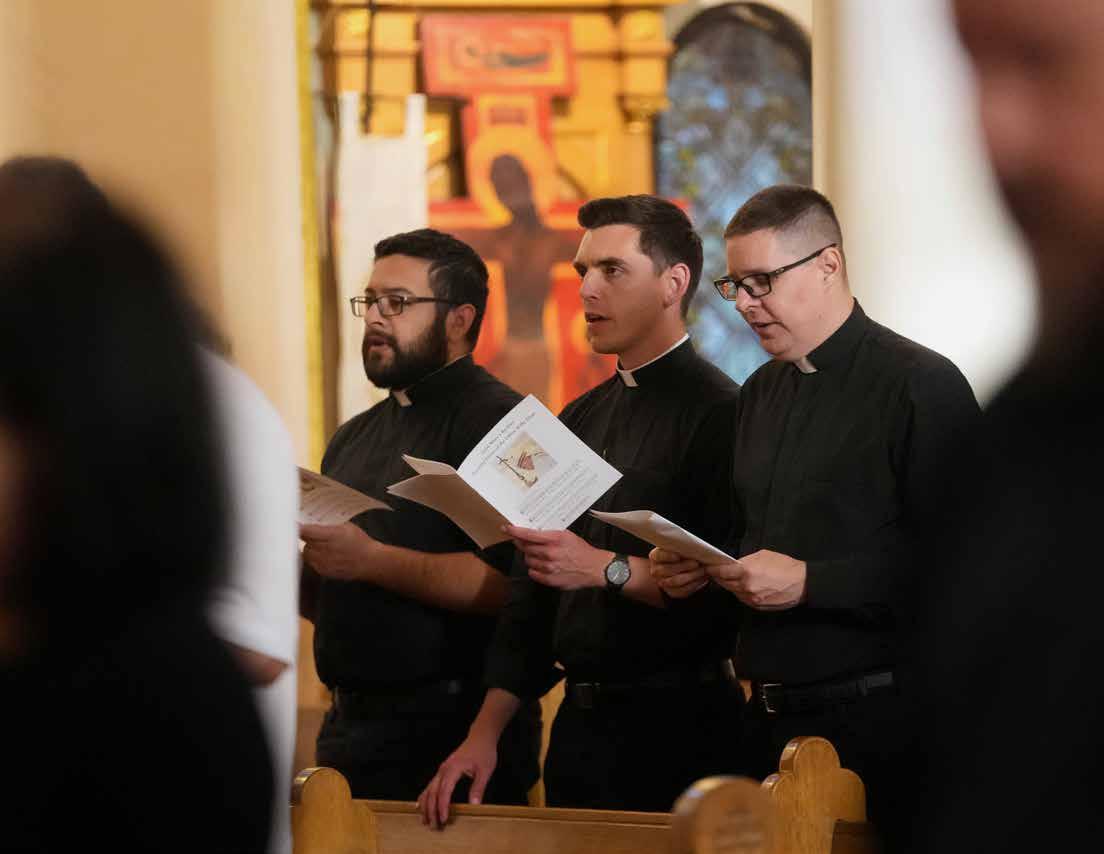
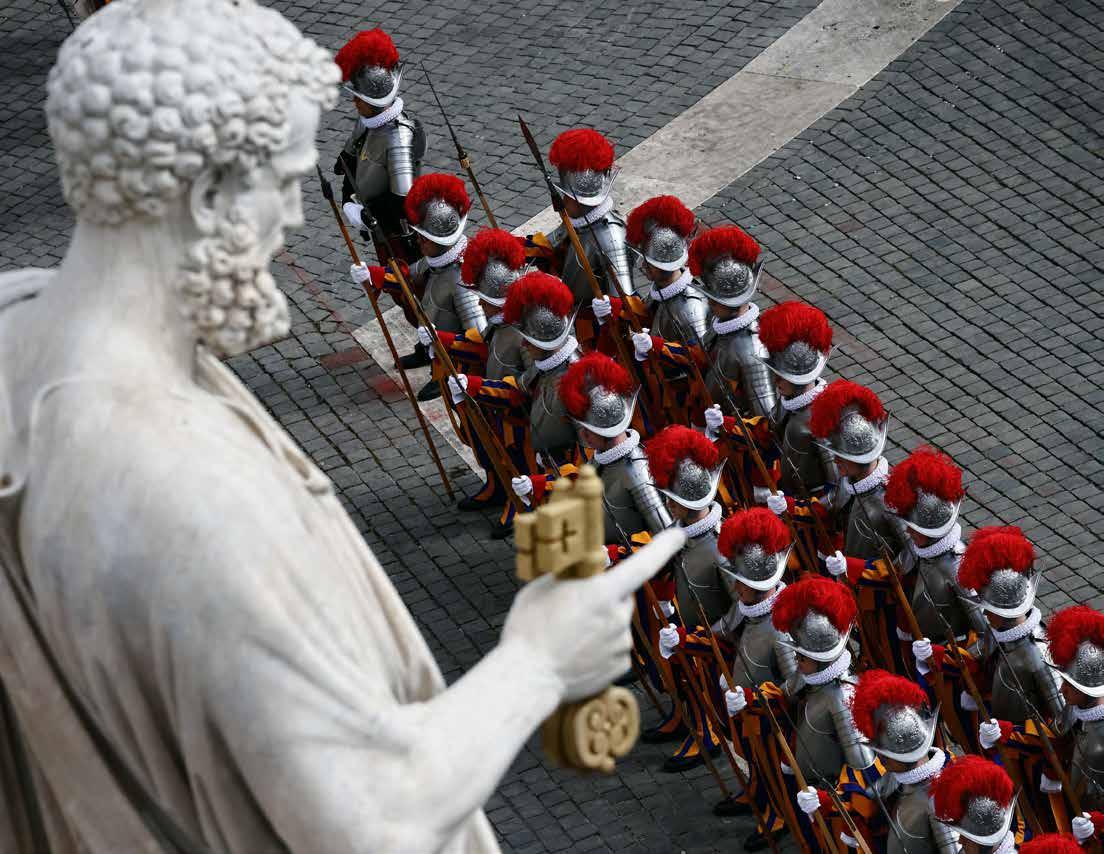
A conclave to choose Pope Francis’ successor
MARC RAMIREZ, USA TODAY
With the passing of Pope Francis, who presided over the Roman Catholic Church and its estimated 1.4 billion followers for 12 years, attention now turns to the selection of his successor.
The decision is made through a time-honored process known as the conclave, which the Vatican announced will start on May 7. The conclave is an election conducted in secrecy behind the locked doors of the Vatican’s Sistine Chapel.
Conclaves are held only when the papacy is vacated, typically upon a pope’s death or retirement. When Pope Benedict XVI, citing age and faltering health, stepped down from the post in 2013 after eight years as pontiff, it was the first time any pope had done so in nearly six centuries.
The resignation of Benedict, who died in 2022, prompted the conclave that elected Pope Francis as head of the church. Francis, 88, died of a stroke on April 21, Easter Monday, after a long respiratory illness.
Soon, the College of Cardinals, the
church’s most senior members and the acting head of the church until a new pope is selected, will convene to choose the new pontiff. Only those under age 80 are eligible to vote; of the church’s 252 cardinals, 135 will serve as electors, according to the Vatican.
HOW MANY POPES HAVE THERE BEEN?
Pope Francis was the 266th pope in the Roman Catholic Church’s nearly 2000-year history. The first pope was St. Peter, the apostle of Jesus Christ.
WHEN DOES THE CONCLAVE START? HOW
LONG DOES IT LAST?
The conclave, customarily held 15 to 20 days after the pope’s death, will start May 7. There is no set time limit for the conclave; the longest conclave in modern times took place in 1903, when Pope Pius X was chosen after five days. In the 13th century, the papacy was vacant for three years before Gregory X was elected. According to CatholicVote.org, the process to elect Pope Gregory X took so long that several electors died before the
decisive vote. The stalemate prompted procedural changes that endure today.
Pope Benedict XVI was elected in 2005 in two days.
HOW
LONG WAS THE LAST CONCLAVE?
In 2013, it took the College of Cardinals’ 115 electors a little more than a day — 28 hours — to choose Jorge Mario Bergoglio of Argentina as Benedict’s successor. Backed by cardinals seeking reform, the low-profile Bergoglio emerged as a surprise contender early on, and his momentum continued.
Bergoglio, who took the papal name Francis, was the first pope to originate from the Americas, a distinction in which he reveled in his very first speech, saying, “I come from the end of the world.”
WHAT HAPPENS DURING THE CONCLAVE?
The conclave is a storied, timeworn tradition filled with ritual and global intrigue. Before it begins, the members of the College of Cardinals will first celebrate Mass in St. Peter’s Basilica before
OPPOSITE: Members of the Swiss Guard stand near a St. Peter statue in St. Peter’s Square in 2025. YARA NARDI / REUTERS
gathering in the Sistine Chapel.
Until a successor is chosen, they will sequester behind the Renaissance-era chapel’s locked doors — hence the term conclave, from the Latin “with key.” While the isolation was initially intended to shield the college from the influence of Roman leaders and powerful families, now it’s the pressures of the media: The cardinals are given no access to phones, television, email or other public contact. The cardinals are sworn to secrecy, though a few details have inevitably squirmed outside through the chapel walls over the years.
HOW MANY SECRET BALLOTS ARE TAKEN EACH DAY?
Up to four secret ballots are conducted daily. Electors scrawl handwritten votes on slips of paper. A pope is chosen when he garners two-thirds of the vote. Each time no candidate earns a sufficient portion of votes, the cardinals break for closed-door discussion and eventually reconvene for another vote, with the process repeating until a decision is made.
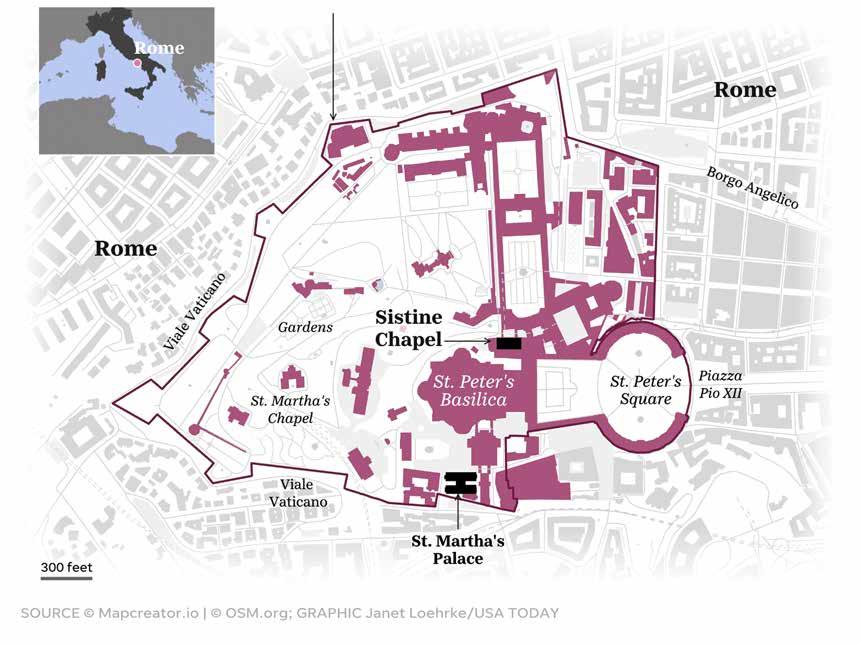
Meanwhile, outside the chapel in St. Peter’s Square, thousands of faithful will gather in prayer and anticipation awaiting the cardinals’ verdict. Batches of paper slips representing indecisive tallies are burned using chemicals that produce black smoke from the chapel chimney.
bianco,” or chemically produced white smoke, issuing from the chimney.
The public will know a new pope has been chosen when they see the “ fumo
If no clear winner is named after 33 rounds of voting, the top two candidates advance to a run-off but the winner must
still attain a two-thirds majority. Ultimately, the words “Habemus papam” — “We have a pope” — will sound from the balcony and the newly named pope will make his debut.
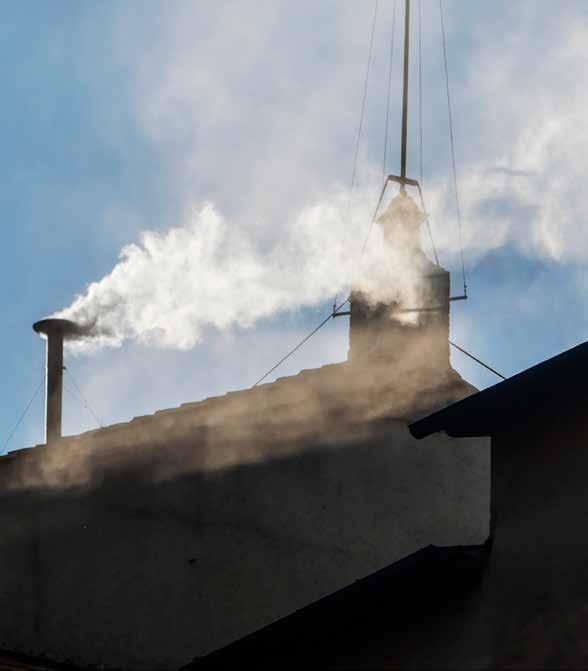
What security measures are taken for the conclave?
Under church law, cardinals must gather within 15 to 20 days after the death of a pope to choose a successor. For the papal conclave, the Sistine Chapel is closed to the public and several security precautions are taken to prevent outside influence.
• The chapel and nearby rooms are electronically swept for cameras, or other surveillance or listening devices.
• Cardinals and support staff swear on the Bible, under penalty of excommunication, to keep all deliberations secret.
• Cardinals are secluded during the conclave and are forbidden from any communication with the outside world.
• A temporary wood floor, or platform, is added to protect the marble floor.
• Two temporary stoves are installed to burn ballots.
• Devices that jam electronic signals are installed on the chapel’s walls.
• Wi-Fi access in the Vatican is shut down.
• The Vatican’s Swiss Guards are stationed outside the chapel to prevent unauthorized entry.
Once inside, a cardinal can’t leave except for illness or extreme circumstances.
Cardinals eat together during the conclave, but even the menu is restricted. Foods in which messages could be concealed, like pies or chicken, are prohibited.
Was this the fastest conclave in history?
MARY WALRATH-HOLDRIDGE, USA TODAY
White smoke rose from the Sistine Chapel just after 6 p.m. Vatican time (noon ET) on May 8, 2025, signaling to the world that a new pope had been selected. The papal conclave to elect Pope Francis’ successor began the day prior, when 133 elector cardinals gathered under a vow of secrecy to cast their votes beginning that evening. The day finished out around 9 p.m. local time with billows of black smoke rising above the Vatican, indicating that the new head of the
Catholic church had not yet been chosen.
After the initial voting on the first day, the subsequent days of the conclave entail voting four times per day: twice in the morning and twice in the evening. In 2013, Pope Francis was selected on the second day after five rounds of voting. Before him, Pope Benedict XVI was
chosen on the second day after just four rounds.
This time, it again took until late on the second day of voting and at least four ballots for the white smoke to appear. This may seem quick, but it actually is not the fastest conclave decision in history. The shortest conclave in known history lasted
just 10 hours and ended with the election of Pope Julius II in 1503.
More recently, as in the last 100 years, the shortest conclaves lasted a day when Pius XII was elected in 1939 after three rounds of voting. John Paul I was elected on the second day in 1978 after four rounds.”
RIGHT: A billboard along a Chicago highway displays a message of support for Pope Leo XIV after Cardinal Robert Prevost of the United States was announced as Pope Leo XIV. CARLOS OSORIO / REUTERS
OPPOSITE: Wreaths at the front entrance were adorned with the Vatican colors of white and gold for the Mass in Thanksgiving for the Election of Pope Leo XIV at the Cathedral of the Assumption in Louisville, Kentucky, on May 12, 2025. SAM UPSHAW JR. / COURIER JOURNAL
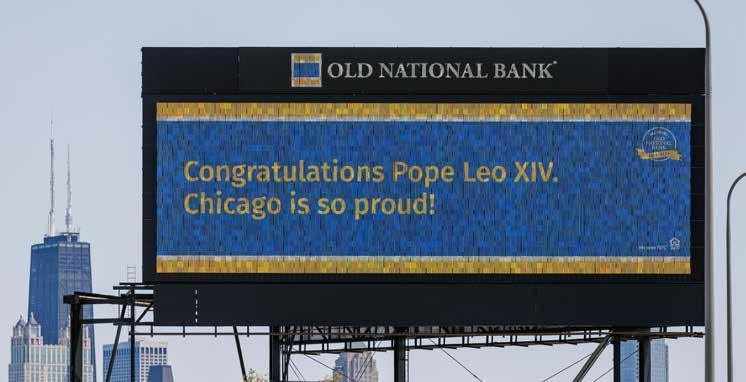
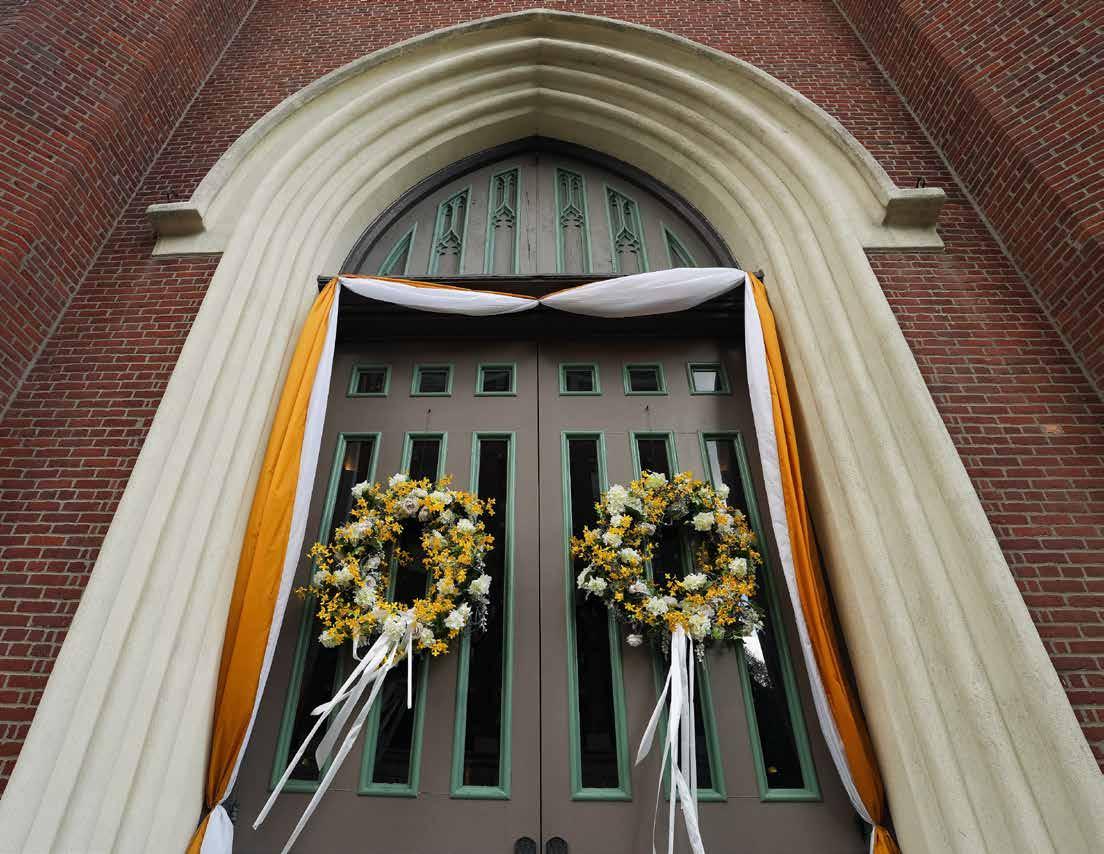
What does choice of ‘Leo XIV’ say about how he wants to lead?
GEORGE PETRAS, USA TODAY
Cardinal Robert Francis Prevost, 69, took the name Leo XIV after the papal conclave elected him the Catholic Church’s 267th pope — the first from the U.S.
The conclave’s choice of Prevost surprised Catholics around the world, who are now wondering what lies ahead for the church, with an American pontiff as its leader.
Prevost’s papal name Leo XIV indicates “he’s sending a kind of moderate message to the Catholic faithful,” says Dr. Michael Pasquier, associate dean in the College of Humanities and Social Sciences at Louisiana State University.
WHAT NAMES HAVE POPES CHOSEN MOST OFTEN?
Over the centuries, Leo is one of the top five most popular names chosen by popes. One of them, Pope Leo XIII, elected in 1878, was known as a reformer.
He encouraged diplomacy, advocated scientific process, and favored a strong church position on human rights.
In taking the name of Pope Leo XIV, “many are thinking that Prevost is trying to thread a needle, in signaling that he’s mindful of Catholic social teaching and the mission of the church to serve the poor and the marginalized in ways that are very similar to (Pope) Francis’ approach,” Pasquier says.
However, Prevost also recognizes the importance of maintaining church tradition “in light of this changing modern world,” Pasquier says.
WHY IS A NEW POPE’S NAME SIGNIFICANT?
A pope’s new moniker, known as a papal name or a regnal name, is “the first message a new pope sends, even before he speaks,” the National Catholic Register says.
Popes can take the names of their predecessors or saints “out of respect, admiration, or recognition,” according to the Vatican News. That can include a desire to follow or emulate the intentions of past popes.
Conversely, taking a different or unexpected papal name can signal changes ahead in church doctrine, which is why the name and its historical connections will be analyzed as soon as it’s revealed.
Canon Law doesn’t require a pope to change his name. There is, however, one unwritten rule: a pontiff can’t take the name of Peter, out of deference to St. Peter, who is traditionally known as the Catholic Church’s first pope.
WHAT NAMES HAVE NEW POPES TAKEN?
Historians will study the name for clues to its meanings and connotations.
The 21 legitimate uses of “John,” for
example, reflect “the richness of the name being associated with the Gospel as well as John the Baptist and John the Evangelist, not to mention John of the Cross and other saints,” the National Catholic Register says.
WHAT PAPAL NAMES ARE NEVER CHOSEN?
Besides Peter, other names that have not been taken by newly elected popes include: Andrew. James. Joseph. Luke.
Only two popes have taken double names: John Paul I, in August 1978, and John Paul II, who succeeded him in October 1978.
OPPOSITE: A person reads a newspaper with an image of Pope Leo XIV, on the day Pope Leo XIV holds his inaugural Mass at the Vatican, on May 18, 2025. DARRIN ZAMMIT LUPI / REUTERS

‘A monumental day’: Catholics in Washington embrace the first U.S.-born pope
CHRISTOPHER
CANN, USA TODAY
WASHINGTON, DC — Across the nation’s capital, Catholics joyously welcomed the news of the church’s first U.S.-born pope.
“I never thought in my lifetime I would see an American pope,” said the Rev. Msgr. W. Ronald Jameson, the director of St. Matthew’s Cathedral. “Today is an extremely joyful day.”
On May 8, the most senior figure in the Roman Catholic Church chose Cardinal Robert Francis Prevost to be the 267th pope just one day after the papal conclave commenced. Originally from Chicago, the 69-year-old served more than four decades as a missionary and a bishop in Peru, where he became a naturalized citizen.
The new pontiff, who chose the name Leo XIV, was not among the favorites to succeed Pope Francis, who died in April 2025 at the age of 88. Still, his selection was a welcomed surprise for many Americans.
Jameson, who leads operations at the mother church of the archbishop of Washington, said the announcement of Pope Leo XIV “totally shocked” him.
Leo’s ascension to the top of the Catholic Church was a surprise, Jameson said, because being a U.S. citizen was long considered a barrier to the papacy.
The monsignor anticipates the new pontiff would pick up where Francis left off, advocating for the poor and for immigrants and pushing for unity, peace and inclusivity.
“He is someone who will continue the work of Francis and, for me, that’s very important,” Jameson said, watching as a crew of maintenance workers traded the black bunting with a vibrant white and gold draping to commemorate a new pope with the colors of the Holy See.
When Gabby Innamorato and some of her coworkers heard the cardinals had selected a new pope, she rushed out of her office and headed into St. Matthew’s
Cathedral across the street.
Innamorato, who works at a nonprofit, said she was unfamiliar with the new pontiff’s name as she was hoping for Luis Antonio Tagle, of the Philippines, to succeed Francis. But, after listening to Pope Leo XIV’s first words from the balcony of St. Peter’s Basilica, she feels hopeful that the new leader of the Catholic Church, like Francis, will be “a man of the people.”
“This is a surprise, but not in a bad way,” she said. “I just did not expect it.”
Lucero Rossi, 36, said Leo was the kind of pope she has been praying for since Francis’ death.
To Rossi, who was born in Mexico but works in the U.S. as an economist, the issues that matter most are immigration and the environment. And in the short time she’s spent reading up on Leo’s statements, she believes he will follow in his
predecessor’s footsteps and push for progress on both issues.
“He seems to have a very pro-immigrant agenda,” she said, “so I am very happy about that.”
Rossi watched as he made his first public appearance at St. Peter’s Basilica,

opening in Italian with “Peace be with you all.” But what stuck out most of all was the moment he greeted his diocese in Chicago and Peru in Spanish — not English.
“I really loved that,” she said. “That was an embrace of the Latin American world.”
Isaac Sagastume, an ordained priest for the Archdiocese of Washington, said “it’s a very exciting time for the church in the United States.”
Sagastume, who announced to a roaring applause at the start of the afternoon Mass that white smoke could be seen emanating from the chimney of the Sistine Chapel — indicating a new pope had been chosen. He said Leo is a leader well suited to deal with the world’s many current affiliations.
“He was a candidate that had experience of the church in the U.S., but also in Latin America and the church at large,” said Sagastume.
Standing outside the church where he briefly met Pope Francis in 2016, Sagastume said Francis “set a path” for Leo and he hopes to see a “pastoral continuation” from the new head of the Vatican.
U.S. politicians also chimed in with well wishes and kind words for the new pontiff. Speaking to the media, President Donald Trump said, “To have the Pope from America is a great honor.”

“He has demonstrated that he believes in justice for the poor and immigrants,”
Rep. Robert Garcia, the first PeruvianAmerican member of Congress, said on X that he wishes Leo “strength as he steps into his role as a global and spiritual leader.”
Garcia said. “May his leadership reflect these ideals as he spreads peace across the world.”
Hours after Leo made his first formal greeting as the new pope, a crowd of faithful Catholics filled the pews at the Basilica
of the National Shrine of the Immaculate Conception, the largest Catholic church in North America.
As the evening mass began, the Rev. Msgr. Vito Buonanno, pronounced “He’s American!” to a thunderous roar of applause. “I never thought I’d live to see it,” he added.
ABOVE: Newly elected Pope Leo XIV, Robert Prevost appears at the main central loggia balcony of the St Peter’s Basilica for the first time, after the cardinals ended the conclave in the Vatican. ALESSIA GIULIANI / IMAGO / CATHOLIC PRESS
